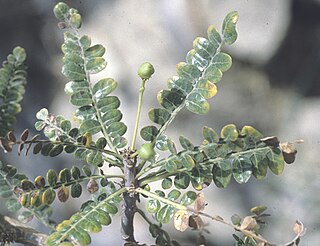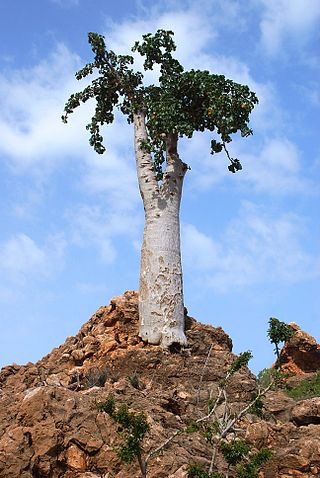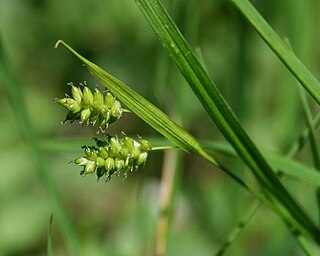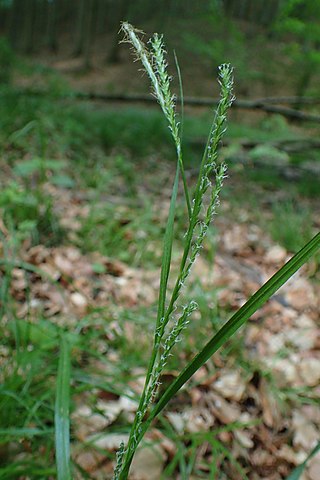
Crotalaria socotrana is a species of plant in the family Fabaceae. It is endemic to north-central Socotra in Yemen. Its natural habitat is subtropical or tropical dry forests.

The Socotra bunting is a species of bird in the family Emberizidae.
Boswellia nana is a species of plant in the Burseraceae family endemic to the Yemeni island of Socotra. They are small trees or shrubs, sometimes so bent that they are lying nearly horizontal to the ground.

Boswellia socotrana is a species of plant in the Burseraceae family. It is endemic to Socotra, Yemen. Its natural habitats are subtropical or tropical dry forests and subtropical or tropical dry shrubland.
Priva socotrana is a species of plant in the family Verbenaceae. It is a subshrub endemic to the islands of Socotra and Samhah in Yemen's Socotra Archipelago. It is common and widespread in dry shrublands and woodlands on limestone escarpments and plateaus from 50 to 950 metres elevation.
Pyrostria socotrana is a species of flowering plant in the family Rubiaceae. It is a shrub endemic to the Hajhir Mountains on the island of Socotra in Yemen. It grows in submontane semi-deciduous woodland from 850 to 1,000 metres elevation.

Thamnosma socotrana is a species of plant in the family Rutaceae. It is a subshrub endemic to the Hajhir Mountains on the island of Socotra in Yemen. It has evergreen, strongly aromatic leaves with strongly inrolled margins. It is locally common in low montane shrubland from 700 to 1,400 metres elevation.
Wellstedia socotrana is a species of flowering plant in the family Boraginaceae. It is a subshrub native to northeastern Somalia and southern Socotra.

The Socotra Island xeric shrublands is a terrestrial ecoregion that covers the large island of Socotra and several smaller islands that constitute the Socotra Archipelago. The archipelago is in the western Indian Ocean, east of the Horn of Africa and south of the Arabian Peninsula. Politically the archipelago is part of Yemen, and lies south of the Yemeni mainland.

Dendrosicyos is a monotypic genus in the plant family Cucurbitaceae. The only species is Dendrosicyos socotranus, the cucumber tree. The species is endemic to the island of Socotra in Yemen, and is the only species in the Cucurbitaceae to grow in a tree form. The species name was originally spelled D. socotrana, but this is corrected to masculine grammatical gender according to the International Code of Nomenclature for algae, fungi, and plants.

Senna sophera is a shrub or tree in the bean family Fabaceae. It is now widespread in tropical and subtropical regions of the world, but is believed to be native to tropical America. Originally described by Carl Linnaeus in 1753 as Cassia sophera, it has acquired a large number of synonyms. Vernacular names include algarrobilla, baner, kasunda, kasaundi (Hindi) and kolkasunda (Bengali).. This tree is called Gnazhar tree in Tamil. The flower of this tree has been extensively referred in poems of Sangam Tamil litterature.
Begonia samhaensis is a species in the family Begoniaceae. Similar to Begonia socotrana but separated by the asymmetrically ovate leaves and the unequal tepals in the male flowers; outer tepals broadly orbicular, 1.5–2.2 × 1.7–2.5 cm; inner obovate elliptic, 1.4–2.0 × 0.8 × 1.4 cm.

The Socotra Archipelago, officially the Socotra Archipelago Governorate, abbreviated to Socotra Governorate, is one of the governorates of Yemen. It includes a number of islands in the Indian Ocean south of mainland Yemen, the largest of which is Socotra.

Carex pallescens, called pale sedge, is a widespread species of flowering plant in the genus Carex, native to the northeastern United States, eastern Canada, Iceland, Europe, Tunisia, and western Asia. It has unstable chromosome numbers.

Carex praecox, the spring sedge, is a species of flowering plant in the genus Carex, native to Europe, western Asia, and Mongolia. Its diploid chromosome number is 2n=58, with some uncertainty.

Carex strigosa, the thin-spiked wood sedge, is a species of flowering plant in the genus Carex, native to Europe and the Caucasus region. Its diploid chromosome number is 2n=66.

Carex melanostachya, called the Great Plains sedge, is a species of flowering plant in the genus Carex, native to central Europe to western Asia, and introduced to the central US. Its chromosome number is 2n=54, with some uncertainty.

Carex lachenalii, called the twotipped sedge and hare's foot sedge, is a species of flowering plant in the genus Carex, native to temperate and subarctic North America, Greenland, Iceland, Europe, and Asia, and the South Island of New Zealand. Its diploid chromosome number is 2n=64, with some uncertainty.

Commiphora socotrana is a species of flowering plant in the incense tree family Burseraceae, native to Socotra. A shrub or small tree, it is dominant in the laakam myrrh tree shrubland and is found in many other woodland and shrubland biotopes.













